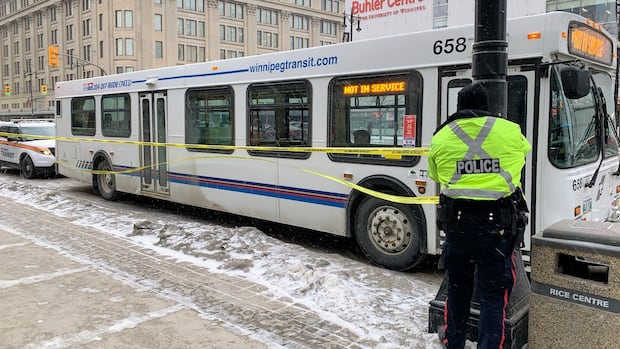Manitoba·NewIncidents of violence on Winnipeg Transit vehicles, or at bus stops or shelters, have climbed by nearly 300 per cent since 2018, one of the steepest increases in violence among Canadian cities, data shows.Winnipeg Transit violent incidents increased 281% between 2018 and 2024, Stats Can data showsListen to this articleEstimated 5 minutesThe audio version of this article is generated by text-to-speech, a technology based on artificial intelligence.The majority of Winnipeg Transit violence happens in the city’s downtown, data from the Winnipeg Police Service shows. (Darren Bernhardt/CBC)This story is a collaboration between CBC News and the Investigative Journalism Foundation (IJF).Winnipeg has seen one of the sharpest increases in violence on its transit network among Canadian cities, and although the number of reported incidents dipped slightly last year, violence across the system remains near record highs.CBC News and the Investigative Journalism Foundation collaborated to looks at transit violence across Canada. The cities included in the investigation are the only census metropolitan areas in the country whose police services consistently track and report whether violent incidents occurred on transit locations.City% Increase 2018-2024Winnipeg+281.08%Edmonton+199.19%Kitchener/Waterloo+194.87%Montreal+170.17%Toronto+127.22%Hamilton+69.70%Calgary+58.11%Vancouver+3.05%A review of Statistics Canada’s uniform crime reporting data — which standardizes how police services across the country categorize and report violent offences — shows violent crimes reported on Winnipeg Transit vehicles, at bus stops and in transit shelters have risen 281 per cent since 2018. Between 2018 and 2024, violent incidents recorded on buses or near Winnipeg Transit stops rose from 104 in 2018 to a peak of 314 in 2023, before dropping slightly to 286 incidents in 2024. YearNumber of Incidents% Change from Previous Year2018104—2019129+24.0%2020115–10.9%2021149+29.6%2022218+46.3%2023314+44.0%2024286–8.9%Using data from the Winnipeg Police Service, obtained through a freedom of information request, CBC News mapped every transit-related violent incident recorded between 2018 and 2024. It shows the overwhelming majority of incidents occur in or near the downtown core, with south Portage and the Portage-Ellice corridor far outpacing every other part of the city. The Statistics Canada data breaks violent incidents into categories, including common assault, assault with a weapon or causing bodily harm, aggravated assault, and other violent offences such as robbery, uttering threats, forcible confinement and sexual offences.Common assault makes up the largest share of violent transit incidents in Winnipeg — 571 out of 1,315 incidents reported by police overall, with 51 incidents in 2018 and 132 in 2024, an increase of 158 per cent. The numbers also show a rise in assaults involving weapons or bodily harm, up from 10 in 2018 to 74 in 2024, which union officials say matches what front-line operators are seeing.”It’s upsetting and disturbing … but not all that much of a surprise,” said Chris Scott, president of the Amalgamated Transit Union 1505, which represents Winnipeg Transit employees.”We are still getting regular reports of incidents happening on the bus … and it just demonstrates how much more work we need to do to make transit service safe in the city. “It’s disappointing that every record that Winnipeg seems to set is a negative record instead of a positive record, and we need to fight to change that.”While there was a slight decrease in violent incidents reported by Winnipeg police in 2024, which coincided with the launch of the city’s new community safety team in February of that year, Scott says incidents of violence in 2025 have been on the rise, and may even surpass the 2023 number.”As soon as they started patrolling the buses, we saw numbers drop,” he said. “But it didn’t take long before they started to escalate again.”Scott said operators are reporting a rise in weapons, from BB guns to makeshift weapons and thrown objects. The psychological toll of threats and spitting incidents weighs heavily on drivers as well, he said.The city’s proposed 2026 budget does not include funding for full bus operator enclosures, something the union says is urgently needed.Comparisons may not be ‘apples-to-apples’: councillorCoun. Janice Lukes, chair of the Winnipeg city council’s public works committee, agreed that the safety teams have made a noticeable difference, but cautioned against over-interpreting cross-city comparisons.”Stats and numbers are not going to be exactly apples-to-apples from city to city,” she said.But Lukes said Winnipeg’s addiction crisis and concentration of poverty downtown make an increase in transit incidents here unsurprising. Earlier this fall, the city and Winnipeg police launched a temporary initiative deploying uniformed and plainclothes officers onto buses, along with stepped-up fare enforcement. Initiatives like those are already changing operator feedback “night and day,” according to Lukes.Police say the program is cost-neutral, using redeployed resources, and runs until the end of the year before being reviewed.Winnipeg Transit rider Lucas Lambert, a University of Manitoba student, says to him, most daytime university routes feel safe — but that changes at night, particularly downtown.”Even the buses going to the university late at night don’t feel really safe,” he said. “It’s more the safety coming off the bus that’s the problem, in my opinion,” he said. Waiting at bus stops “or going back home after the bus stop, I’d say is the worst thing.”ABOUT THE AUTHORCameron MacLean is a journalist for CBC Manitoba living in Winnipeg, where he was born and raised. He has more than a decade of experience reporting in the city and across Manitoba, covering a wide range of topics, including courts, politics, housing, arts, health and breaking news. Email story tips to cameron.maclean@cbc.ca.
Wednesday, 26 Nov 2025
Canada – The Illusion
Search
Have an existing account?
Sign In
© 2022 Foxiz News Network. Ruby Design Company. All Rights Reserved.
You May also Like
- More News:
- history
- Standing Bear Network
- John Gonzalez
- ᐊᔭᐦᑊ ayahp — It happened
- Creation
- Beneath the Water
- Olympic gold medal
- Jim Thorpe
- type O blood
- the bringer of life
- Raven
- Wás’agi
- NoiseCat
- 'Sugarcane'
- The rivers still sing
- ᑲᓂᐸᐏᐟ ᒪᐢᑿ
- ᐅᑳᐤ okâw — We remember
- ᐊᓂᓈᐯᐃᐧᐣ aninâpêwin — Truth
- This is what it means to be human.
- Nokoma












